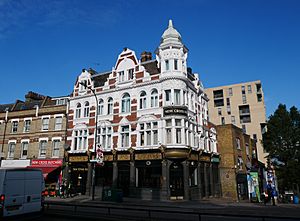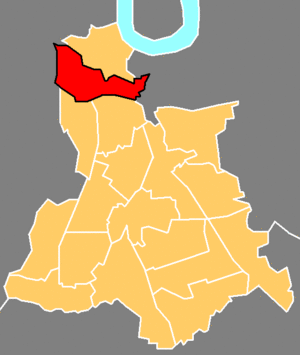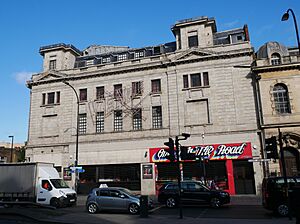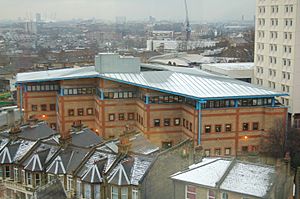New Cross facts for kids
Quick facts for kids New Cross |
|
|---|---|
 The New Cross Inn |
|
| Population | 15,756 (2011 Census.Ward) |
| OS grid reference | TQ365765 |
| London borough | |
| Ceremonial county | Greater London |
| Region | |
| Country | England |
| Sovereign state | United Kingdom |
| Post town | LONDON |
| Postcode district | SE14,SE15 |
| Dialling code | 020 |
| Police | Metropolitan |
| Fire | London |
| Ambulance | London |
| EU Parliament | London |
| UK Parliament |
|
| London Assembly |
|
New Cross is a lively area in south-east London, England. It's about 4.5 miles south-east of the city center, Charing Cross. This area is part of the London Borough of Lewisham and uses the SE14 postcode. New Cross is close to other interesting places like St Johns, Telegraph Hill, and Greenwich. It's also home to important schools and a university, including Goldsmiths, University of London, Haberdashers' Hatcham College, and Addey and Stanhope School.
The western part of New Cross is called New Cross Gate. This name comes from an old tollgate set up in 1718. Here you'll find New Cross station and New Cross Gate station. This area used to be known as Hatcham.
Template:TOC limit=3
Contents
Discovering the History of New Cross
The area we know as New Cross was originally called Hatcham. You can still see this name in local church names and schools today. The first mention of Hatcham was in the Domesday Book in 1086. This was a very old survey of England.
For many years, the land in Hatcham belonged to a monastery called Bermondsey Abbey. After monasteries were closed down, the land was bought by the Haberdashers' Company in the 1600s. This was a rich group that helped develop the area in the 1800s. Telegraph Hill, a nearby area, was once covered in market gardens owned by this same company. Before 1889, New Cross was part of the counties of Kent and Surrey.
New Cross likely got its name from an old coaching house. This was a place where horse-drawn coaches would stop. It was first called the Golden Cross. A famous diarist, John Evelyn, wrote in 1675 that he met a friend at 'New Crosse'.
In the late 1800s, New Cross became known as the "New Cross Tangle." This was because of all the railway lines, workshops, and two train stations. Both stations were originally called New Cross, but one was later renamed New Cross Gate.
The Hatcham Iron Works in Pomeroy Street was an important factory. It built steam locomotives. In 1865, there was a big disagreement between the factory manager and the workers. The workers met at a local pub to discuss their strike.
New Cross bus garage was once London's biggest tram depot. It opened in 1906. During a big strike in 1926, police had to clear a large crowd of people blocking the entrance. The very last London tram ran from Woolwich to New Cross in July 1952.
During World War II, on November 25, 1944, a V-2 rocket hit the Woolworths store in New Cross Road. Tragically, 168 people lost their lives. It was one of the worst V-bomb attacks in London. A special plaque was put up in 2009 to remember this event.
In August 1977, a big event called the Battle of Lewisham happened here. People who were against racism stood up to a far-right group.
On January 18, 1981, a terrible fire at 439 New Cross Road killed 13 young black people. Many people believed it was a racist attack. This event led to a huge protest by black people across Britain.
Culture and Community in New Cross
Music Scene in New Cross
New Cross has a rich music history. In the 1980s, the Goldsmiths Tavern hosted fun cabaret nights. New acts like Julian Clary performed there. The Goldsmiths' Students' Union also had many famous bands play, such as The B-52's and The Pogues.
In the 1990s, The Venue nightclub was a key spot for Indie Rock and Brit Pop bands. Many big names like Oasis, Radiohead, and Pulp played gigs there. Music magazines like Touch are also based in New Cross.
New Cross is known as the birthplace of "New Rave" music. This scene started with a group of artists and DJs called !WOWOW! who held parties in New Cross from 2003. Bands like Klaxons started their careers here. Goldsmiths, University of London, also has a student opera company called Opera Gold.
Sporting Life in New Cross
Millwall Football Club was based in New Cross for many years. Their old stadium, The Den, was in Cold Blow Lane from 1910 to 1993. It could hold over 45,000 fans. Millwall later moved to a new stadium, The New Den, which is still very close to New Cross.
Speedway racing also took place at the New Cross Speedway and Greyhound Stadium. This track was known as "The Frying Pan Bowl" because it was one of the shortest. It operated at different times until 1963. The stadium also hosted the UK's first stock car race in 1954. Today, the stadium site is an open space called Bridge House Meadows. A 1949 speedway film, Once a Jolly Swagman, was filmed here.
Dance and Arts
New Cross was home to the Laban Centre for many years. This is now called Trinity Laban Conservatoire of Music and Dance. It's a famous place for dance, where choreographers like Matthew Bourne trained. Although Laban moved to Deptford, it still uses its New Cross campus.
Local Library
New Cross Learning, formerly known as the New Cross People's Library, was saved from closing down. After protests in 2011, it reopened in 2013. It is now run by the community. It offers learning activities and has over 5,000 books.
Demographics of New Cross
The New Cross area has some interesting facts about its population. For example, the New Cross ward has the lowest female life expectancy in all of Greater London, at 77.6 years. For males, it's 74.3 years.
Important Buildings in New Cross
New Cross is close to Deptford and Greenwich, which have strong links to the sea. Because of this, the Royal Naval School was built in New Cross in 1843. It was for the sons of naval officers. The school moved in 1889. The building was then bought by the Worshipful Company of Goldsmiths. They opened a technical institute there in 1891. This later became Goldsmiths, University of London in 1904.
The old Deptford Town Hall building is also in New Cross Road. It's now used by Goldsmiths. It was built between 1903 and 1905. You can see carvings of sea creatures and statues of admirals on the building. There's even a sailing ship weathervane on the clock tower.
The New Cross Fire Station is a Grade II listed building. This means it's a special historical building. It was built in 1893–94.
The Kingdom Hall of Jehovah's Witnesses used to be the South East London Synagogue. This synagogue was started in 1888 by Jewish people who came to Britain from Eastern Europe. The original synagogue was destroyed by a German air raid in 1940. A new one was built in 1956. However, the number of people attending declined, and the synagogue closed in 1985.
The Venue nightclub in New Cross Road has a long history. It opened in 1925 as the New Cross Super Kinema, a cinema with a dance hall above it. It changed names several times and closed as a cinema in 1960. Later, the old dance hall became The Harp Club and then The Venue nightclub. It has recently changed its name to 'One For The Road' and now functions more as a bar.
The Duke of Albany public house (a pub) was used as the outside of The Winchester pub in the film Shaun of the Dead. It was turned into flats in 2008.
Getting Around New Cross: Transport
Rail Connections
New Cross has two train stations: New Cross and New Cross Gate.
Both stations are served by London Overground trains. From New Cross Gate, you can travel south to places like Crystal Palace and West Croydon. You can also go north to Highbury & Islington. New Cross station is the end of the line for services from Dalston Junction.
New Cross also has regular train services run by Southeastern. These trains usually go north to Cannon Street or Charing Cross. To the south-east, they go to places like Lewisham and Dartford.
New Cross Gate has train services run by Southern. These trains generally go north to London Bridge. To the south, they go to places like London Victoria, East Croydon, and even Gatwick Airport.
Major Roads
Three main roads meet in New Cross. The A202 (Queen's Road) goes from New Cross to Victoria. The A2 (New Cross Road) connects London to Canterbury and Dover. The A20 (Lewisham Way) runs from New Cross to Folkestone and Dover.
Famous People from New Cross
Music Stars with New Cross Roots
- Many bands like Art Brut, Bloc Party, and Blur have been linked to the "New Cross scene."
- British hip-hop producer JFlames grew up here.
- Hip-hop artist Blade often mentioned New Cross in his songs.
- 1970s glam rocker Steve Harley grew up in New Cross.
- Music hall star Marie Lloyd lived in Lewisham Way.
- Nathan Cooper and Chi-Tudor Hart from the electro group Matinée Club grew up in New Cross.
- RnB group Damage had members who attended a local school.
- The folk noir band Songdog lived in New Cross when they first moved to London.
- Dire Straits played some of their first gigs in New Cross pubs.
- Jools Holland performed in New Cross pubs early in his career.
- The band The Band of Holy Joy was formed in New Cross in 1984.
- British dance-pop artist Jessie Ware lives in New Cross.
- P Money, a British rapper, is also from New Cross.
Other Notable Residents
- Poet Robert Browning lived near New Cross Road in the 1840s.
- Trade unionist Eddie Dempsey was born and raised here.
- Playwright Terence Frisby was born in New Cross.
- Boxing writer Harry Mullan lived in New Cross for many years.
- Wrestler Mick McManus was born in New Cross.
- Actress Laila Morse, known from EastEnders, lives in New Cross.
- Actor Gary Oldman was born and grew up in New Cross. His film Nil By Mouth is based on his childhood here.
- Footballer Kieran Richardson spent some of his childhood in New Cross Gate.
- Sir Barnes Wallis, a famous inventor, lived at 241 New Cross Road.
- Artist Edward Henry Windred lived here in the 1930s.
- Radio presenter Steve Wright.
- Many famous artists and musicians studied at Goldsmiths, University of London, including Damien Hirst, John Cale, and Mary Quant.
- Princess Beatrice of York studied at Goldsmiths, though she didn't live in New Cross.
Places Nearby New Cross
- Bermondsey
- Blackheath
- Brockley
- Deptford
- Greenwich
- Lewisham
- Rotherhithe
- Southwark
- Nunhead
- Peckham
- Telegraph Hill (part of New Cross)
- Crofton Park
New Cross in Song
- The band Carter USM wrote a song called "The Only Living Boy in New Cross" (1992).
- The tragic New Cross Fire was remembered in several reggae songs and poems. These include Johnny Osbourne’s "13 dead and nothing said" and Benjamin Zephaniah’s "13 dead."








